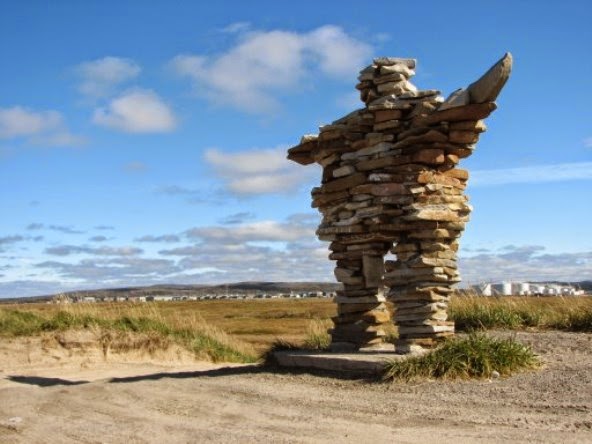I expect all my blog readers including my
french readers to be as curious as I am about the Inuit and their culture. Please share this interest with as many people as you can.
Earlier on in the year, as I was speaking to a friend about my project, I was asked why I deemed it so important to do this project. My answer was that I felt that I had not accomplished what I wanted when I was there in 2009 and so, I have a task, unfinished,
with and for the Inuit. At this point, I cannot predict my results but I am acting in such a way that things happen to
give my project its own life.
Meeting the Inuit
When I first met the Inuit back in 2009, I was able to communicate with them almost immediately even if I did not speak Inuktitut. They came to me easily. Maybe it was because they considered me an elder. Being an elder counts in the Inuit culture. “Elders” are considered culture-bearers. Respect is not only a matter of one’s chronological age: elders are perceived as role models who serve as advisors, philosophers and professors.
It would be a lie to say I’m in charge of this project. My perception is that I will need to meet with as many Inuit elders as possible to guide me in this work. They know their people; I have less than basic knowledge of the Inuit. It would help me to participate in all kinds of activities that are organized by various Inuit organizations and community groups. I need to participate in forums and happenings that concern them. I would like to learn the language to understand their way of thinking better. Although I am very lucky to have an Inuit friend, my project is for them that need it.
The Inuit mothers’ competences
Let me tell you what I know about them. You will need to read this very interesting
report to make your own mind concerning them.
The Inuit history promotes pride in the Inuit identity
The
Inuit history promotes pride in the Inuit identity and that is good. The Inuit are part of their land: they know how to use the resources of their land. Solidarity is an Inuit value. They have a community freezer in each community and are quite generous with their community and family members. The meat left in the freezer by the hunters and the fishermen is free and easily accessible for anyone needing it.
The relationship between the generations is evident amongst women
Belonging is important to the Inuit. So the young women learn from their elders how to sew, how to make traditional clothing, and while the work is being done, they discuss. The relationship between the generations is evident amongst women.
Collaboration is habitual
When I visited and participated with the women at the women’s workshop, I noticed a high degree of collaboration among them as they went about scraping the skins, preparing a pattern for kamik and pualuk. Some women were natural leaders and the others rallied as a cohesive group to work on such projects such as sewing or knitting hats with a special pattern.
They have competences that can be used by each community to ensure that the community is alive and well. From my point of view, they simply are not invited to develop skills to help their children to become stronger people. I know there are efforts in that sense, but there are many
obstacles.
The attachment factor
In fact, Inuit mothers do a lot of things right. Starting with their coats, called amauti . The amauti, also amaut or amautik, plural amautiit is the parka worn by Inuit women of the eastern Canadian arctic. Up until about two years of age, the child nestles against the mother's back in the amaut, the built-in baby pouch just below the hood. The pouch is large and comfortable for the baby ((Wikipedia). I have seen 3 year-old tots being carried still. The mothers habitually show a lot of caring for their children.
Terms of Endearment
Because time does not mean the same thing for the Inuit as in my culture, there is time for the children, time to watch them play cards, time to nap with them, time to sing, time to let them be who they are. They illustrate
quinuituq.
Children are shown by example
Responding to a human need for emotional and physical comfort from others, they often huddle together to share a cigarette or a meal. One can sense that
they are comfortable with one another.
Children are shown by example. They eventually imitate their parents. It was with wonder that I would observe the children on Sundays in church services. They wormed their way over and under the seats while parents watched on serenely.
Inuit children learn by example.
Those are the strengths I was able to observe while I spent time in different communities. Surely it is surely the basis of any community-based project.
Resourcefulness is a kind of thinking
Their ability to be resourceful, to seek solutions and use resources creatively demonstrates adaptability and flexibility in response to their rapidly changing world. Their skilled perseverance contributes to a collective
level of wisdom which is nurtured from infancy.


_Akuluk_(Term_of_Endearment)_375.jpg)